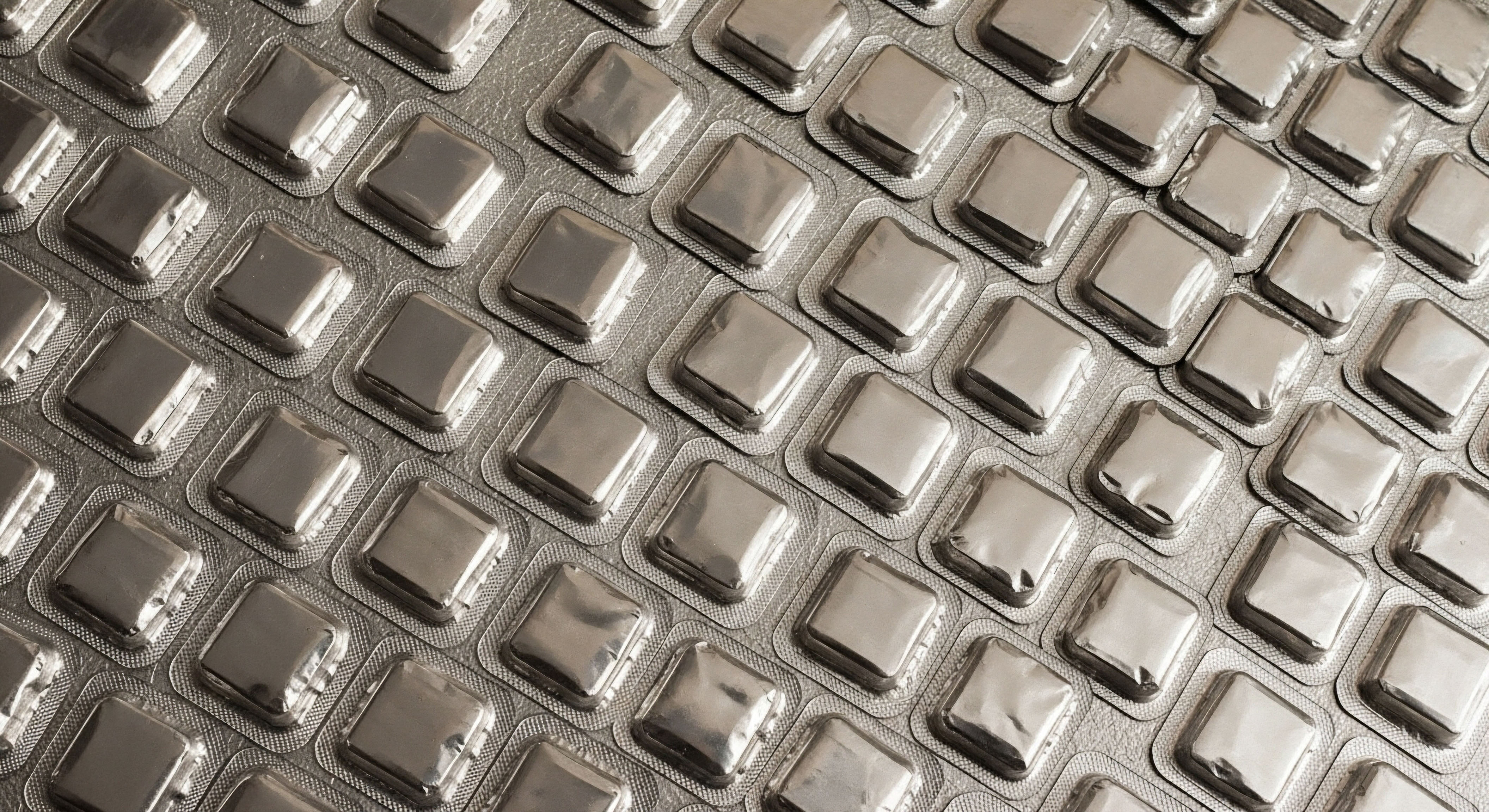

Fundamentals
The decision to begin a hormonal optimization protocol is often born from a desire to reclaim a sense of vitality. You felt the symptoms of low testosterone ∞ the fatigue, the mental fog, the loss of drive ∞ and sought a solution to restore your body’s peak function.
The introduction of therapeutic testosterone can feel like a biological homecoming. Yet, this recalibration introduces a profound shift in your body’s internal communication network, specifically the system responsible for fertility. Understanding this shift is the first step in navigating the path back to restored sperm production.
Your reproductive health is governed by a precise and continuous conversation between your brain and your testes. This system, known as the Hypothalamic-Pituitary-Gonadal (HPG) axis, functions like a highly responsive thermostat. The hypothalamus in your brain monitors testosterone levels. When it senses a need, it sends a signal, Gonadotropin-Releasing Hormone (GnRH), to the pituitary gland.
The pituitary, acting as a command center, then releases two key messenger hormones into the bloodstream ∞ Luteinizing Hormone (LH) and Follicle-Stimulating Hormone (FSH).
LH travels to the Leydig cells in the testes, instructing them to produce testosterone. FSH signals the Sertoli cells, the “nurseries” of the testes, to begin and maintain sperm production, a process called spermatogenesis. This entire feedback loop is designed to keep your internal hormonal environment in a state of dynamic equilibrium.
When you introduce testosterone from an external source through TRT, your hypothalamus senses that testosterone levels are high. It concludes that the system is already saturated with the final product. Consequently, it ceases sending its GnRH signal. The pituitary gland goes quiet, LH and FSH levels fall, and the testes, receiving no instructions, halt both testosterone and sperm production. This is a normal, adaptive response of a healthy biological system.
Exogenous testosterone administration suppresses the body’s natural signaling for sperm production by silencing the hypothalamic-pituitary-gonadal axis.

The Biological Silence and the Path to Awakening
The state of suppressed spermatogenesis you experience after beginning TRT is a direct, predictable outcome of this intelligent biological adaptation. Your body has simply turned down the volume on its own production because it senses an abundance of testosterone. The challenge, and the solution, lies in reawakening this dormant communication pathway. The goal of a fertility restoration protocol is to restart the conversation between the brain and the testes, prompting the pituitary to once again release LH and FSH.
This process requires a targeted pharmacological approach designed to mimic the body’s natural signals. We are essentially sending a “wake-up call” to the pituitary and the testes, reminding them of their roles. The medications used are designed to intervene at specific points in the HPG axis to reinstate the cascade of hormonal events that leads to healthy sperm production.
The effectiveness of these protocols is rooted in their ability to work with your body’s own sophisticated physiological architecture. The process is a guided restoration of an innate biological function.


Intermediate
Restoring fertility after a period of hormonal optimization involves a deliberate and methodical approach to restarting the HPG axis. The process uses specific medications that act as biological keys, unlocking the body’s own machinery for sperm production. These interventions are tailored to re-establish the signaling that was paused during therapy. The primary agents used fall into distinct classes, each with a unique mechanism for stimulating the system.

Gonadotropin-Based Protocols the Direct Stimulators
Gonadotropins are hormones that directly stimulate the gonads (testes). In a post-TRT context, we use pharmaceutical versions of these hormones to replicate the function of the now-suppressed LH and FSH. This approach bypasses the hypothalamus and pituitary, speaking directly to the testes.
- Human Chorionic Gonadotropin (hCG) This compound is structurally very similar to Luteinizing Hormone (LH). When administered, it binds to the LH receptors on the Leydig cells in the testes, signaling them to resume testosterone production. This intratesticular testosterone is essential for spermatogenesis. hCG acts as the primary catalyst to “turn the factory back on.”
- Human Menopausal Gonadotropin (hMG) or Recombinant FSH (rFSH) While hCG effectively restarts testicular testosterone production, Follicle-Stimulating Hormone (FSH) is the direct signal for the Sertoli cells to support and mature sperm cells. For comprehensive restoration, especially after prolonged suppression, co-administration of an FSH-containing product is often necessary to fully support the spermatogenesis process.
A typical protocol might involve injections of hCG several times a week, sometimes combined with FSH injections, to provide both signals the testes require.

Selective Estrogen Receptor Modulators the Pituitary Re-Sensitizers
Selective Estrogen Receptor Modulators (SERMs) work further up the HPG axis, at the level of the pituitary gland and hypothalamus. Testosterone is converted into estrogen in the male body, and estrogen is a key part of the negative feedback signal that tells the brain to stop producing GnRH, LH, and FSH. SERMs strategically block the estrogen receptors in the brain.
By blinding the hypothalamus and pituitary to the presence of estrogen, SERMs trick the brain into thinking hormone levels are low. This prompts the pituitary to increase its output of LH and FSH, thereby sending the natural, endogenous signals for the testes to produce testosterone and sperm. Common SERMs used in these protocols include:
- Clomiphene Citrate (Clomid) A well-established SERM that effectively boosts LH and FSH production.
- Enclomiphene Citrate An isomer of clomiphene that is thought to have a more targeted effect on increasing gonadotropin levels with fewer side effects.
- Tamoxifen Citrate Another SERM that can be used to stimulate the HPG axis.
Medications for fertility restoration function either by directly stimulating the testes or by reawakening the brain’s natural hormonal signaling.

Comparing Primary Restoration Agents
The choice between gonadotropins and SERMs depends on the individual’s specific situation, including the duration of TRT and baseline hormone levels. The following table provides a comparison of these approaches.
| Medication Class | Mechanism of Action | Primary Target | Typical Administration |
|---|---|---|---|
| Gonadotropins (hCG, FSH) | Directly stimulates the testes by mimicking LH and FSH. | Leydig and Sertoli cells in the testes. | Subcutaneous or intramuscular injections. |
| SERMs (Clomiphene, Enclomiphene) | Blocks estrogen receptors in the brain, causing an increase in natural LH and FSH production. | Hypothalamus and Pituitary Gland. | Oral tablets. |

The Role of Aromatase Inhibitors
Aromatase Inhibitors (AIs) such as Anastrozole represent another tool. These medications work by blocking the aromatase enzyme, which converts testosterone into estrogen. By lowering overall estrogen levels, AIs reduce the negative feedback on the pituitary, which can help increase LH and FSH output. They are often used as an adjunct therapy, particularly in men who have a high rate of aromatization, to help optimize the hormonal ratios needed for effective spermatogenesis.


Academic
A sophisticated understanding of fertility restoration post-androgen therapy requires a detailed examination of the hypothalamic-pituitary-gonadal (HPG) axis regulation. The administration of exogenous testosterone induces a state of secondary hypogonadotropic hypogonadism.
This condition is characterized by low serum levels of LH and FSH due to the potent negative feedback exerted by circulating androgens and their estrogenic metabolites on the hypothalamus and pituitary. The central clinical objective is to overcome this iatrogenic suppression and reinstate endogenous gonadotropin secretion and subsequent spermatogenesis.

Re-Establishing Pulsatile Gonadotropin Secretion
The physiological secretion of GnRH, and consequently LH and FSH, is pulsatile. This pulsatility is fundamental to maintaining receptor sensitivity and appropriate downstream signaling in the gonads. Continuous, non-pulsatile stimulation can lead to receptor downregulation and desensitization. The therapeutic challenge is to mimic this natural rhythm to achieve a sustained biological response.
Selective Estrogen Receptor Modulators (SERMs) are particularly effective in this regard. By acting as antagonists at estrogen receptors (ERα) in the hypothalamus and pituitary, they disrupt the primary negative feedback loop. This perceived estrogen deficiency prompts the hypothalamus to increase the frequency and amplitude of GnRH pulses.
The pituitary, in turn, responds by synthesizing and releasing LH and FSH, re-establishing the signaling cascade to the testes. Enclomiphene citrate is often preferred for this purpose due to its profile as a pure estrogen antagonist, which contrasts with the mixed agonist/antagonist properties of zuclomiphene, the other isomer in standard clomiphene citrate.
Effective fertility restoration hinges on re-establishing the natural pulsatile release of gonadotropins, which is critical for testicular receptor sensitivity.

Direct Gonadal Stimulation a Synergistic Approach
While SERMs work to restart the endogenous engine, direct stimulation with exogenous gonadotropins provides a more direct, albeit pharmacologically driven, pathway. Human Chorionic Gonadotropin (hCG) is a glycoprotein hormone that shares an identical alpha subunit with LH, TSH, and FSH, and a beta subunit that confers a high degree of structural homology with LH.
This allows hCG to bind to and activate the LH receptor on testicular Leydig cells, initiating steroidogenesis and elevating intratesticular testosterone (ITT) levels. High concentrations of ITT are an absolute prerequisite for the initiation and maintenance of spermatogenesis in the Sertoli cells.
However, ITT alone is insufficient for robust sperm production. Spermatogenesis is a complex process also requiring direct FSH stimulation of Sertoli cells. FSH signaling is critical for the proliferation of spermatogonia and the completion of meiosis. A recent retrospective cohort analysis highlighted the efficacy of a combined approach.
In this study, a protocol using 3,000 IU of hCG and 75 IU of FSH three times a week resulted in improved sperm concentrations in 74% of men with a history of testosterone use. This demonstrates that a dual-pronged stimulation, replicating the actions of both LH and FSH, provides a comprehensive environment for sperm maturation.

What Factors Influence the Timeline for Recovery?
The time required to restore spermatogenesis is highly variable and depends on several factors. Research indicates that recovery probability stands at 67% at 6 months, 90% at 12 months, and approaches 100% by 24 months after cessation of androgens. Key influencing variables include:
| Factor | Impact on Recovery | Mechanism |
|---|---|---|
| Duration of TRT | Longer use can lead to a more profound and prolonged suppression of the HPG axis. | Sustained absence of gonadotropin stimulation may lead to cellular changes in the testes that take longer to reverse. |
| Age | Older individuals may experience a slower recovery. | Age-related decline in testicular function and HPG axis responsiveness can compound the suppressive effects of TRT. |
| Baseline Fertility Status | Pre-existing subfertility can complicate and lengthen the recovery process. | The protocol is restoring function to a baseline that may have already been compromised. |
| Concomitant Medications | The specific protocol used (e.g. SERMs vs. gonadotropins) directly influences the recovery pathway. | Direct gonadotropin stimulation may yield faster results in some cases compared to the indirect action of SERMs. |
The choice of protocol must be guided by a thorough clinical evaluation, including baseline semen analysis and hormone profiling, to create a personalized strategy that addresses the specific physiological state of the individual.

References
- Coward, R. M. & McBride, J. A. “Recovery of spermatogenesis following testosterone replacement therapy or anabolic-androgenic steroid use.” Asian Journal of Andrology, vol. 18, no. 3, 2016, pp. 373-380.
- Patel, A. S. et al. “Optimal restoration of spermatogenesis after testosterone therapy using human chorionic gonadotropin and follicle-stimulating hormone.” Fertility and Sterility, vol. 123, no. 4, 2025, pp. 607-615.
- McBride, J. A. & Coward, R. M. “(Open Access) Recovery of spermatogenesis following testosterone replacement therapy or anabolic-androgenic steroid use.” SciSpace, 2016, doi:10.4103/1008-682X.173938.

Reflection

Charting Your Personal Path Forward
The information presented here illuminates the biological pathways and clinical strategies involved in restoring fertility. This knowledge is the foundational map. Your personal health, however, is the unique territory to which this map applies. The data on recovery timelines and the mechanisms of specific medications provide a framework for what is possible. They represent the collective experience of many, yet the next steps are yours alone, guided by expert clinical partnership.
Consider the systems within your own body. This process is about more than just a single hormone or a specific cell count. It is about re-establishing a fundamental biological dialogue that was intentionally paused.
As you move forward, the most valuable tool you possess is this understanding of your own physiology, paired with the guidance of a clinician who can help interpret your body’s specific responses. Your journey toward restored function is a proactive, collaborative effort rooted in the powerful science of endocrinology.

Glossary

sperm production

pituitary gland

follicle-stimulating hormone

luteinizing hormone

spermatogenesis

sertoli cells

fertility restoration

hpg axis

human chorionic gonadotropin

intratesticular testosterone

hcg

selective estrogen receptor modulators

negative feedback

serms

clomiphene citrate

anastrozole

secondary hypogonadotropic hypogonadism




